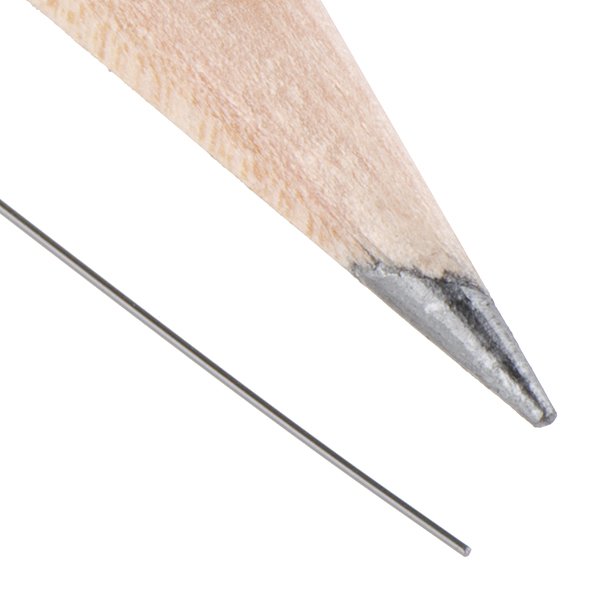Muscle Wire® - 0.012" Diameter (1 foot)
This 0.012" Muscle Wire® (aka shape memory Nitinol) is a one foot long piece of nickel-titanium alloy that can flex and contract when a specific amount of heat or current is applied to it. If you are asking yourself "What sorcery is this?!" We assure you, this isn't magic, it's just simple science thanks to shape memory and a change between the wires weaker, low temperature form (martensitic) and its stronger, high temperature form (austenite).
When the Muscle Wire® is in its martensitic form, it can be formed and bent into different shapes. However, when an electrical current of ~1.5A is applied to the wire, or is heated to ~100C it reverts to austenite form and recovers its previous shape with great force. Additionally, you can anneal at ~500C (use an industrial furnace or simply a lighter) it to whatever shape you would want, next once that current or heat is applied it will return to that new shape.
Note: The datasheet found below is for Flexinol® actuator wire, that isn't exactly like all Muscle Wire® but it's close. Flexinol® Actuators Wires are made specifically for linear actuators to replace small motors or solenoids..
- Length: 305mm
- Diameter: 0.30mm
- Current Required for Austenite Form: 1.5A
- Pull Force: 2.83lbs
- Resistance: 0.31 ohms/inch
Muscle Wire® - 0.012" Diameter (1 foot) Product Help and Resources
Core Skill: Electrical Prototyping
If it requires power, you need to know how much, what all the pins do, and how to hook it up. You may need to reference datasheets, schematics, and know the ins and outs of electronics.
Skill Level: Noob - You don't need to reference a datasheet, but you will need to know basic power requirements.
See all skill levels
Comments
Looking for answers to technical questions?
We welcome your comments and suggestions below. However, if you are looking for solutions to technical questions please see our Technical Assistance page.
Customer Reviews
5 out of 5
Based on 2 ratings:
1 of 1 found this helpful:
Awesome Thing ! Burnt my finger ....
Excellent material, when you play with it, it makes you realize why we live in the right era of science and how lucky we are to have access to something so exclusive, so magical !
Worked for me with 4 AA Alkaline Battery, the force is strong. While trying to program a new memory shape by tying the wire on a protoboard and run current through it, I burnt my finger !
The wire is shape is programmable by forcing the wire to stay into a desired shape while running currents through it and let it cool down in that shape.



Anyone else think of Batman's cape when they first saw this?
Yes!!!
So is this impossible to solder? I had a bit of luck but It wasn't worth the trouble. I'm guessing I'll need a different way to connect these up.
Do these come with their memory pre-set?
Just heated some of it with a lighter - it appears to have a memory, but not a very useful one.
Hmm, you could wrap the wire around a metal rod of the desired width and then heat with a lighter to create a electro retractable spring.
could this attain its austinite form on 1.2 A
What battery that sparkfun carries would be good with this?
If we asked nicely, would there be a way to get longer lengths of this stuff? :]
we get them precut, so unfortunately, no.
for those that live somewhere other than the US, the Pull Force is 1.2836664 kg (not being too precise about it ;) and the Resistance is 0.31 Ohms / 25.4mm
As I recall, shape-memory wire is best driven by some kind of constant-current or controlled-current source. Of course you can get by with something simpler. I'm thinking measuring the voltage drop across the wire while pwm'ing the power supply would be the way to go with something like an Arduino.
some useful information might be the contraction distance per inch/foot of length used. If i remember correctly it doesnt contract very far for each unit length
3 to 7%, depending on the usage, it's in the datasheet.
Bear in mind, that is what gets you your full pull strength of 2.83 pounds, you can also use the memory effect to achieve greater pull range, but at much lower strength.
Is this material good for quick movement applications ? how fast does it contract? is the speed proportional to the current flowing through the wire?
check out section 2 in the data sheet.
From what I understand, it will change quickly when the current is applied, but can only recover as fast as it can cool down, so there's your gating factor.
But yes, a faster change in temperature will cause it to change faster, up to it's limit. You can increase the rate of increase in temperature with higher current, but some kind of cooling will be needed to speed up the recovery time before it can be flexed again.
As @TeslaFan mentions, it only goes fast in one direction. If you want to use it fast in both directions, hook up a pull-pull setup and energize only one at a time.
However, in this case, consider what happens if you energize a wire before its antagonist cools down back to martensitic form after a preceding movement - it will effectively warp your setup.
So there is still a time limit, even in a push-pull setup, the question is: how big.?
Well, it's based on the thermal transfer coefficiency of the wire, the wire's diameter, the surrounding material the heat has to be transferred to, and the temperature of the surrounding material.
Unfortunately, titanium and nickel are not known for their ability to transfer heat... not like, say, aluminum and copper. So there's that.
Thinner wire cools down faster. surrounding the wire in a material with a high thermal conductivity like water would really speed it up.
My gut feel? At room temperature, with air around the wire? Probably 2 seconds with the .012 wire, less with the thinner gauge.
I SO wanna do an experiment. I want to try to make a muscle / joint with 2 complementing pullers that work against each other (Like muscles in the body.) both "muscles" would be made from several individual wires with their high temp memory in the form of a loose spring. Then all the wires are bundled and enclosed in a silicon sleeve that has coolant (water) flowing through it.
That would be so cool.
Would the wires cool off faster in silicone in water than it would just in the air?
No idea- but if you try it out, let us know what you find!
Heh, this is close to what I had in mind as well. I say go for it (although do be mindful of the temperatures involved)!